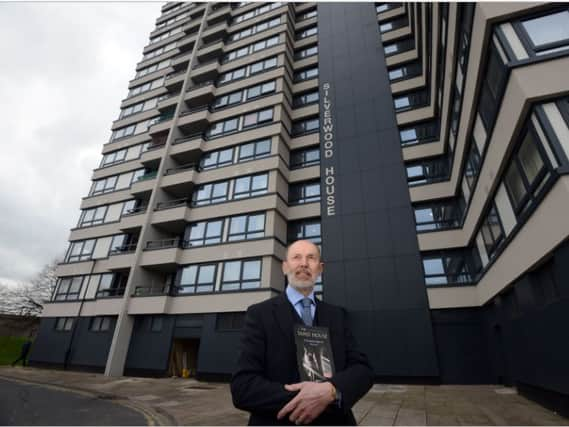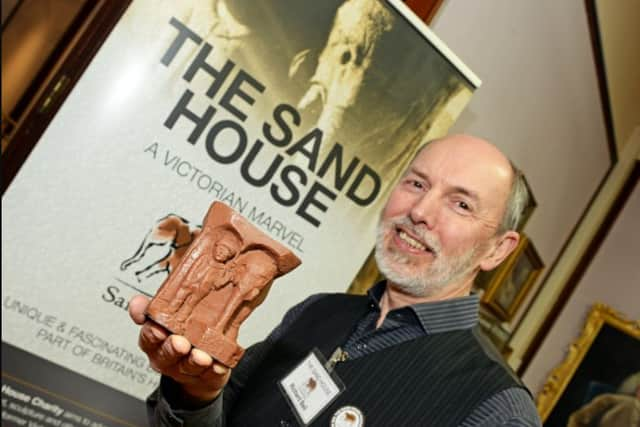Doncaster's 'eighth wonder of the world': The house made of sand with an underground ballroom


In its Victorian heyday, Doncaster’s Sand House was called “the eighth wonder of the world” and compared to Rome’s catacombs and the rock-hewn city of Petra in Jordan. “No description will be equal to that of beholding the place itself,” wrote one early visitor.
Things are rather different today. The house, an ambitious, eccentric enterprise that has inspired a new play opening in June, is buried under a 17-storey block of flats near the town centre. Traffic thunders along a nearby dual carriageway-cum-flyover and trains on the busy East Coast Main Line whoosh past just over the wall.
Advertisement
Hide AdAdvertisement
Hide Ad“The remains are under here,” says Richard Bell, the Sand House’s greatest champion, pointing sadly down at the pavement.


The now-lost but once handsomely furnished ten-room house owed its existence to Bell’s great-great-great grandfather, William Senior – who was a sand merchant – and William’s son Henry, who lived in it for 40 years. Sitting in a former quarry, it wasn’t actually made of sand; it was hollowed out of a huge block of unquarried sandstone and boasted walls up to nine feet thick, stables, and a ballroom that could accommodate 300 people.
Even more intriguingly, it had a network of underground tunnels, cloisters and catacombs lined by carvings – of Queen Victoria, a clown, cherubs and, most strikingly, an elephant and its mahout (driver). Billed as a “grotto tunnel – 1,000 yards, lighted with gas”, it became a novel tourist attraction, particularly during Doncaster’s Race Week.
It lured the curious from as far as Salt Lake City in the USA, with one early 20th century visitor describing it enticingly as “a ghostly sort of place”.
Advertisement
Hide AdAdvertisement
Hide AdRichard Bell, a Doncaster-born-and-based retired civil engineer, remembers his family talking about the house and sharing vintage photographs of it when he was a child.
“It was unique; I’ve never found anything quite like it anywhere else in the world,” he says. “And it was created by my ancestors – and in Doncaster.
“People might think Doncaster never really had much of any significance in its history apart from the Flying Scotsman, the Mallard and the St Leger. But when I give talks about the Sand House, people become enthralled. It really grabs their imagination.”
It’s certainly grabbed his. He has spent 35 years researching the house and has set up a charity to promote it.
Advertisement
Hide AdAdvertisement
Hide Ad“It may be a weird concept to have a charity based on something that doesn’t exist,” he reflects. “But people become fascinated by the subject and it’s a perfectly valid basis to hang educational projects on.”
There’s much more to his involvement than that, though. He has co-authored a massively well-researched book about the house – described as ”a Victorian marvel” – with historian and Yorkshire Post columnist Peter Tuffrey. Its exhaustive detail runs to listing the entire contents of the house sale that followed Henry Senior’s death in 1900, right down to a dog kennel, poultry houses and a night commode.
Bell has given around 250 talks, organised exhibitions, created a stylish website and led guided tours of the area above the house, describing what used to be down there. And there are plans for a Sand House Experience visitor attraction.
“Some people would say it’s an obsession, but I try not to let it rule my life,” he says, leafing through a file of photographs and pointing out where the tunnels would have run. “I like to think it’s doing some good for the town.”
Advertisement
Hide AdAdvertisement
Hide AdThe town, however, hasn’t always been good to the tunnels. The Sand House was bought by Doncaster Corporation after Henry Senior’s death and became the home of a council official. Part of it was used, rather demeaningly, as a store for carts carrying refuse and night-soil.
It was abandoned in the 1930s, its roof was ripped off and its site was gradually filled in with rubble, though the tunnels survived. In the days before Health and Safety clamped down, they became an unofficial children’s playground.
They gradually deteriorated, however, and some of the carvings were vandalised. In 1984 most of the tunnels were filled in, despite a sit-in by protesters angered by this cavalier attitude to Doncaster’s heritage.
One unfilled (though inaccessible) tunnel survives – aptly under the nearby cemetery where the Seniors have a family vault.
Advertisement
Hide AdAdvertisement
Hide AdBefore the tunnels were finally sealed, Bell and other family members were invited to see them. “It was an awesome experience,” he recalls. “Seeing the carvings that I’d only seen on photos up to that time – and the tunnels that my great-great grandfather would have walked through – was a spine-tingling moment.”
He was realistic, though. “I was disappointed when the tunnels were filled in, but as a civil engineer I felt that they were beyond rescue,” he says, and we drive into the town centre for a cup of tea at Cast, the plush new theatre where the Sand House play (called logically enough Sand House) will be staged.
Its author, Leeds-based Peter Spafford, first met Bell during research for a community drama project in Doncaster. He soon realised that the Sand House was “obviously very much his passion for many years”.
The idea of a play evolved, grants were secured from Arts Council England and the Heritage Lottery Fund, and Spafford talked to older people who remembered the tunnels.
Advertisement
Hide AdAdvertisement
Hide Ad“One said he never went in because he was too scared,” he says.
“Another said: ‘You could see bones through the ceiling of the tunnels.’ But you couldn’t. It was like a local urban myth based on strong evidence and history.”
His “family-friendly” play will span that history, interweaving stories set in the Victorian era, the 1940s, the 1980s and the present day, and involving workshops, school visits and an exhibition.
“What interested me was the ambition of Henry Senior – the idea that ‘we’ll make something that Doncaster will be proud of’,” he says.
Advertisement
Hide AdAdvertisement
Hide Ad“It’s a challenge theatrically, because the action takes place both underground and above ground; there will be a lot of sand involved in the set. Sand is very much a metaphor in the play – something you can build things with... and the idea of the sands of time.”
Sand House: June 8 to 10 at Cast, Doncaster. 01302 303959; www.castindoncaster.comwww.thesandhouse.org.uk